We’re having weekly Food Science Camps here in an effort to create our own bit of learning this summer. Today’s lesson is on how to make butter by shaking cream in a jar. The kids all got in on the shaking action, making butter for the next morning’s breakfast.
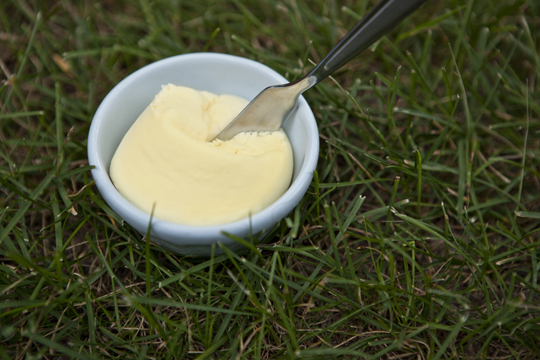
Summer, with its sticky air and bright sun can serve to make us enjoy the outside space, but it can also cause a frenzied state of affairs. When the air is thick it can be hard to motivate myself to do the daily things that need doing: sweeping, watering the garden, putting laundry away and toiling over a sink full of hot water and dirty dishes. (Broken dishwasher. Sob.)
Add to my own toils four kids who would always rather be playing somewhere else or doing something else, and we have a recipe for disaster. There are arguments between siblings. There is a general disregard for the things that need to happen like the making of beds and the putting away of clothes. Tasks like remembering to grab a towel before we run from the pool to the bathroom all the way through the house with grass-covered feet and water dripping from every inch of our body become too difficult to grasp. There are days when they just want to sit and proclaim their state of summer boredom, cry at the sight of mosquito bites and refuse to do anything productive.
To prevent the summer sadness, the outcry of being hot and sticky all the time, I’ve started with our own brand of educational activities that we’re calling Food Science Camp. The kids will create, a lesson will be told and we’ll all be better off for it. Combined with a healthy dose of summer reading motivation thanks to our public library and a newly instituted Daily 5 Chore Chart, we may survive summer yet.
Last week’s lesson involved the making of ice cream (check it out on Food Your Way). It was a particularly hot day, and the hope of slipping into the pool was nil due to a cluster of thunderstorms approaching. We shook up our ice cream with our hands, learning how adding salt to the ice would help the ice cream to freeze.
The Science Behind Butter:
This week we made our own butter. We started with some cream that was just slightly past its use-by date. It had started to smell faintly sour, but not too much. We let it sit to get warm. Leaving the cream out to sour or using cream that has already soured helps bacteria create lactic acid, which is what gives it the sour smell and taste. You can also culture your cream by adding a spoonful or two of yogurt or buttermilk with live cultures to your cream and letting it come to room temperature. Culturing your cream gives butter a rich, full flavor.
Note: It’s not necessary to let it sit to complete the experiment. You can pull it directly out of your fridge and dump it in a jar. I tried to be sure this worked, and it did with just a bit more shaking.
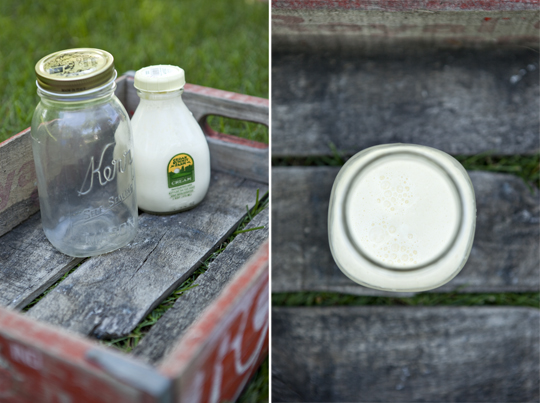
Butter is filled with butter fat globs surrounded by membranes. The lactic acid serves to weaken those membranes until they pop and let the butter fat get together to form the butter and the buttermilk separating off.
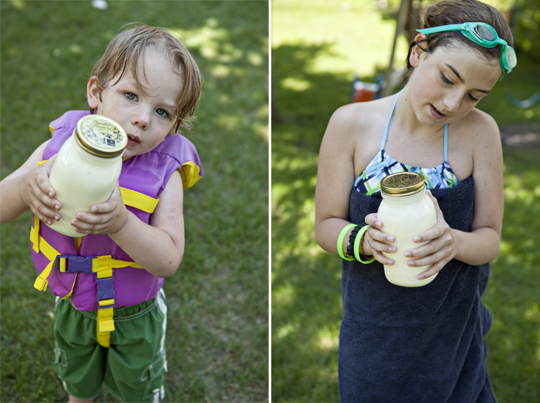
Shake slowly and deliberately. With the kids, I have them grab the neck of the jar and shake up and down, up and down. Some of them can manage this better than others, but they all had a go at it.
My friend Shari from Tickled Red sent this cast cover for Kjell. It’s pretty much the best thing ever from a super sweet redhead. Thank you!
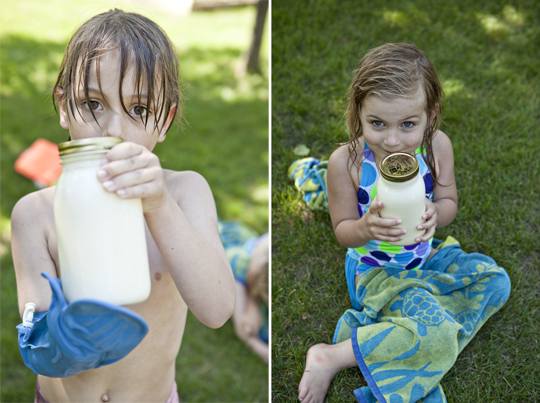
After 3-5 minutes the cream will stop coating the jar and start separating into whey and butter. After this starts, it should only take a few more forceful shakes to get the butter to clump together. Let it stand for a minute, and then pour off the buttermilk into a cup. (Biscuits, anyone?) Did you know the yellow color in butter comes from carotene and cows that are eating grass. Your butter will be a different color depending on what type of cream you use and whether those cows were grass or corn fed.
At this point, you can use the butter, but to make it last longer, rinse it and knead it with ice cold water to get any leftover milk off it, which would spoil in the fridge. (You can pour ice water into the jar and shake it for this.) Continue rinsing until the water is clear.
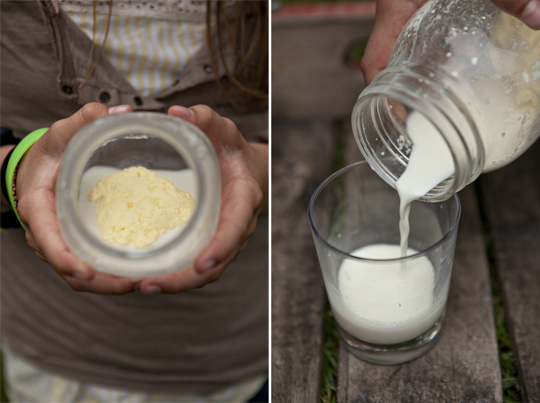
All that is left is to salt your butter and enjoy. Sylvie from Gourmande in the Kitchen just did a cultured butter post earlier this week and made blackberry honey butter, which looks like the perfect breakfast.
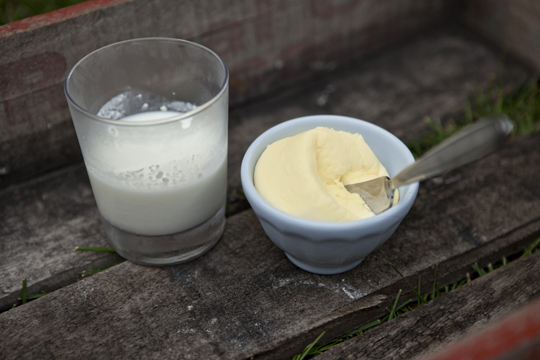
Looking for more? So far in Food Science Camp we’ve made butter in a jar and ice cream in a bag.
1-2 cups ice water
sea salt to taste, optional
Place cream on the counter for 8-12 hours. It is easiest to use cream that is just slightly souring. If your cream is not yet turning, let it sit on the counter for 12 hours to allow bacteria to form lactic acid or add a spoonful of yogurt or buttermilk with live cultures to the cream prior to letting it sit to culture it.
Pour cream into a quart-size canning jar. Begin shaking with slow, deliberate shakes until cream first starts coating the jar, becomes thick like whipping cream and then starts to pull away from the sides, turning to two substances: buttermilk and butter. Let the jar sit for one minute and then pour off the buttermilk into a separate glass.
Pour ice water into the butter to wash it, kneading with hand or stirring to remove any milk, strain off land repeat until water is clear. Strain to leave only the butter in the jar. Stir in salt, if desired. Use immediately or refrigerate until ready to use.
Makes approximately 1/2 cup butter

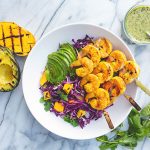
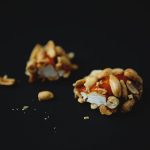
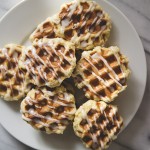

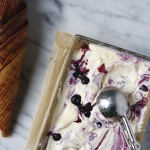
What a fantastic idea for your kids. Wow…they are actually learning about real food. Kudos to you. I bet it was fantastic, too!!
So fun! We have done this many times when we studied the colonial period, but who says we have to wait for that? 🙂
So cool. I remember making butter at my Grandmother’s but have never seen this way of doing it. Fun! And I bet tasty too.
Hey there! I think I might be in butter coma (not that I’m complaining) with all the butter Sylvie did and now this. I seriously can’t wait to go out and buy cream today!
This is such a creative and productive task for the kids. I can imagine they feel really good about seeing the fruits of their labor!
How fun is this food science camp! I need to do this with my kids too. Thanks for the great idea Shaina.
Lovely write up! Reminds me of the time I used to make fresh butter at my mom’s place.
Oh! I remember doing this as a child. What fun!!!
This is SO cool, Shaina! Love it!
This is a great summer project for kids, love it! Thanks for sharing
I got in to a butter making bend one summer, only I didn’t have the benefit of four active kids to help me ‘churn’ it. I just used my K5. It was The. Best. butter I’ve ever had. I had to forcibly stop myself from whirring cream in to butter in order to save my arteries, but wow, it was worth it.
This is so cool. I’ll never forgot making butter with an old lady in northern England while writing my book Food Heroes. It’s so pioneering!
It was great to read this. It brought back memories of making butter on our farm 40 or more years ago. Thanks
Such butter must taste different than bought one, especially for your kids 🙂
So much fun! I think I remember doing something like this in girl scouts. 🙂
Mmm… homemade butter just seems so rustic! I can only imagine the flavor possibilities!
I couldn’t wait to try this, so rushed up town to get some heavy cream and when I asked what it was, I was told it was the same as whipping cream. It has 33% fat in it. Nothing in the store said heavy cream, so I bought it. I let it sit, but only for a couple of hours and since I didn’t have a glass jar, I just used a plastic container and shook the bejeezus out of it. Well, it stopped shaking and when I opened it up….I had no liquid left…only whipped cream. what did I do wrong?? I would really like to make this….
Heavy cream and whipping cream are slightly different. Heavy cream usually has 36% fat or more, while whipping cream is closer to 30%. There is also a possibility that whipping cream has additives to make it more stable, like carrageenan. You want to make sure there is nothing but cream in what you purchased first. Second, during the shaking, the cream will turn first to whipping cream. Continue shaking for it to separate out into buttermilk and butter.
Hope this helps!
Thanks Shaina. I’ll make sure to look for something with more fat in it. BUT….even though it turned to whipping cream and wouldn’t shake anymore…if I kept shaking it, would it have seperated?..OR do I need the heavier fat to do this? And if it turns to whipping cream again…will shaking something that feels solid turn and seperate to butter milk and butter globs??
Yes, you continue shaking it when it feels like it’s whipped cream and not sloshing around. It actually doesn’t take long beyond that to start separating. Because I don’t know exactly what cream you used and whether or not it had stabilizers, I can’t tell if you need a heavier cream, but do try again, and hang in there. Think of it as a good, old fashioned workout.
Love this! I used to do this with my students…such a great little experiment.
This is such a great post! Bookmarking so I can make it…
This sounds so fun!! Conversation that just occurred in my living room: Husband “what are you doing?” Me “Learning how to make butter.” Him “Why would you do that?” Me “Because I can.” 😀
Wow! That looks fun. I’m going to try it out when my nieces come over next weekend. I really like being able to control the quality of the ingredients used. It’s also a good way to recycle slightly old cream instead of tossing it in the garbage.
Hey this is really quite a nice blog post article, liked it out a lot..
This is quite a very nice recipe on butter, so easy to make, i’m surely gonna try it out, thanx..
Thanks for the recipe. Reminds me of how my mom used to make butter back home in India. We had our own cows that we got the milk from every morning and afternoon. Boil the milk and use some to drink. The rest of the milk is made into yogurt. Eat some of the yougurt and the leftover yogurt is let to sit overnight and the next day made into a buttermilk with separating the butter and the buttermilk. we use a simple whisklike instrument to make the buttermilk out of a day old yougurt. its so yummy and made at home.
I love this article, I will try and follow your tips and make my own butter! 🙂
Thanks a lot for sharing this with all of us you really know
what you’re talking about! Bookmarked. Please additionally seek advice from
my web site =). We could have a link change contract between us